- Clone
- QA18A24 (See other available formats)
- Regulatory Status
- RUO
- Other Names
- T-box expressed in T cells, T box 21, TBLYM
- Isotype
- Mouse IgG1, κ
- Ave. Rating
- Submit a Review
- Product Citations
- publications
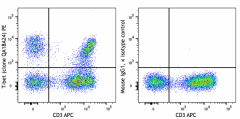
-

Human peripheral blood mononuclear cells (PBMC) were stained with anti-human CD3 APC. Cells were fixed and permeabilized with True-Nuclear™ Transcription Factor Buffer Set, and were stained with anti-human T-bet recombinant (clone QA18A24) PE (left) or mouse IgG1, κ PE isotype control (right).
| Cat # | Size | Price | Quantity Check Availability | Save | ||
|---|---|---|---|---|---|---|
| 365903 | 25 tests | 165 CHF | ||||
| 365904 | 100 tests | 341 CHF | ||||
T-bet, also known as T-box transcription factor T-bet, is considered to be a "master regulator" of Th1 lymphoid development controlling the production of the cytokine IFN-γ. T-bet is widely expressed in hematopoietic cells including stem cells, NK cells, B cells, and T cells. T-bet is critical for the control of microbial pathogens, and knockout animals show multiple physiologic and inflammatory features characteristic of asthma. T-bet expression is optimally observed after IL-12 stimulation and can be suppressed by addition of the Th2 cytokine IL-4 or neutralization of IL-12.
Product DetailsProduct Details
- Verified Reactivity
- Human
- Antibody Type
- Recombinant
- Host Species
- Mouse
- Formulation
- Phosphate-buffered solution, pH 7.2, containing 0.09% sodium azide and BSA (origin USA)
- Preparation
- The antibody was purified by affinity chromatography and conjugated with PE under optimal conditions.
- Concentration
- Lot-specific (to obtain lot-specific concentration and expiration, please enter the lot number in our Certificate of Analysis online tool.)
- Storage & Handling
- The antibody solution should be stored undiluted between 2°C and 8°C, and protected from prolonged exposure to light. Do not freeze.
- Application
-
ICFC - Quality tested
- Recommended Usage
-
Each lot of this antibody is quality control tested by intracellular immunofluorescent staining with flow cytometric analysis. For flow cytometric staining, the suggested use of this reagent is 5 µL per million cells in 100 µL staining volume or 5 µL per 100 µL of whole blood. It is recommended that the reagent be titrated for optimal performance for each application.
- Excitation Laser
-
Blue Laser (488 nm)
Green Laser (532 nm)/Yellow-Green Laser (561 nm)
- Application Notes
-
Clone QA18A24 can completely block the binding of clone 4B10 on target cells.
- RRID
-
AB_2922579 (BioLegend Cat. No. 365903)
AB_2922579 (BioLegend Cat. No. 365904)
Antigen Details
- Structure
- T-box transcription factor, approximately 58 kD.
- Distribution
-
Nuclear; expressed in T cells, hematopoietic stem cells, NK cells, B cells, lung, spleen.
- Function
- Th1-specific T-box transcription factor controlling expression of the hallmark Th1 cytokine, interferon gamma (IFN-γ). T-bet expression is critical for the control of microbial pathogens.
- Interaction
- Human
- Cell Type
- B cells, Hematopoietic stem and progenitors, NK cells, T cells, Tregs
- Biology Area
- Cell Biology, Immunology, Transcription Factors
- Molecular Family
- Nuclear Markers
- Antigen References
-
- Szabo SJ, et al. 2000. Cell. 100:655-69.
- Szabo SJ, et al. 2002. Science. 295:338-42.
- Finotto S, et al. 2002. Science. 295:336-8.
- Mullen AC, et al. 2001. Science. 292:1907-10.
- Gene ID
- 30009 View all products for this Gene ID
- UniProt
- View information about T-bet on UniProt.org
Related FAQs
- What type of PE do you use in your conjugates?
- We use R-PE in our conjugates.
Other Formats
View All T-bet Reagents Request Custom Conjugation| Description | Clone | Applications |
|---|---|---|
| Purified anti-human T-bet Recombinant Antibody | QA18A24 | ICFC |
| PE anti-human T-bet Recombinant Antibody | QA18A24 | ICFC |
| APC anti-human T-bet Recombinant Antibody | QA18A24 | ICFC |
| PerCP/Cyanine5.5 anti-human T-bet Recombinant Antibody | QA18A24 | ICFC |
Customers Also Purchased
Compare Data Across All Formats
This data display is provided for general comparisons between formats.
Your actual data may vary due to variations in samples, target cells, instruments and their settings, staining conditions, and other factors.
If you need assistance with selecting the best format contact our expert technical support team.
-
Purified anti-human T-bet Recombinant Antibody

Human peripheral blood mononuclear cells (PBMC) were stained... -
PE anti-human T-bet Recombinant Antibody

Human peripheral blood mononuclear cells (PBMC) were stained... -
APC anti-human T-bet Recombinant Antibody

Human peripheral blood lymphocytes were surface stained with... -
PerCP/Cyanine5.5 anti-human T-bet Recombinant Antibody

Human peripheral blood lymphocytes were surface stained with...
 Login / Register
Login / Register 









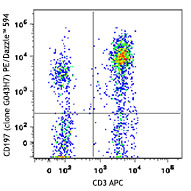
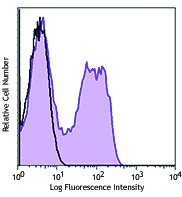
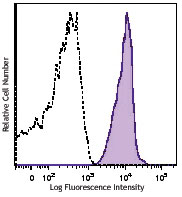
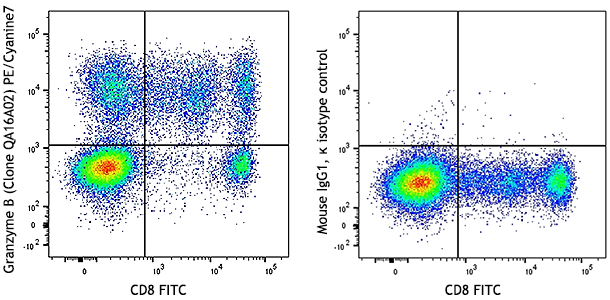



Follow Us